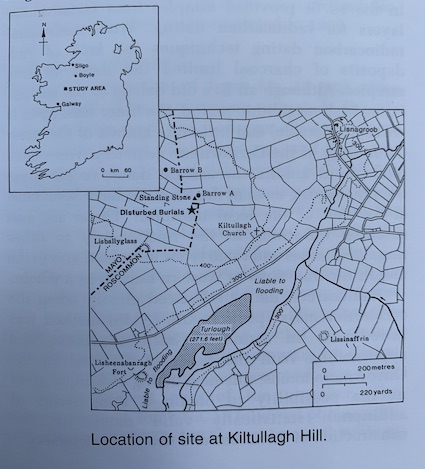1998:561 - KILTULLAGH HILL, Kiltullagh, Roscommon
County: Roscommon
Site name: KILTULLAGH HILL, Kiltullagh
Sites and Monuments Record No.: N/A
Licence number: 96E0179 ext.
Author: M.E. Robinson and D.G. Coombs, Department of Geography and Department of Art History and Archaeology, University of Manchester
Author/Organisation Address: Manchester M13 9PL, England
Site type: Burial ground
Period/Dating: Multi-period
ITM: E 552961m, N 774018m
Latitude, Longitude (decimal degrees): 53.713725, -8.712574
Excavations on Kiltullagh Hill took place in 1994 and 1996 (F. McCormick, Excavations 1994, 76, 94E030; D.G. Coombs and K. Maude, Excavations 1996, 95, 96E0179) and over a three-week period in 1998. The hill is a small but distinctive eminence of carboniferous limestone that straddles the border of counties Roscommon and Mayo. The surrounding landscape is a subdued complex of esker and bog with slow and chaotic drainage.
Interest in the hill stems from the accidental find in 1991 of fragmentary human remains in a small quarry on the Mayo side of the border. Radiocarbon dates from these remains placed them in the late Iron Age. Subsequent excavation has concentrated on the Roscommon side of the border.
In previous seasons, excavation focused on the site of a standing stone (1994) where a single extended adult inhumation was recovered, and a small ring-barrow (1996) that produced the disturbed remains of two adult inhumations. On both occasions small, unprotected, cremation pits were also found. The excavation of the barrow also produced a single, small, blue glass bead. Radiocarbon dating of the inhumation remains at both sites suggested the possibility of Early Christian burials, while the standing stone, ring-barrow and cremation pits point to an earlier, pagan site. The excavation in 1998 was designed to allow positive identification of an Early Christian cemetery and to clarify other phases of site use.
A series of three complete inhumations was recovered. Two of these were adults, probably one male and one female, and one was a child. All three had been buried according to Christian tradition with their heads to the west and their feet to the east, in inhumation pits that were defined by discontinuous large stones and backfilled with a stony, calcareous loam. No grave-goods accompanied any of the burials. In addition to these complete inhumations excavation recovered the isolated skull of a child and part of the cranial vault of an adult, together with a single vertebra and some loose teeth. At the time of writing no dates are available, but there seems to be good reason to suspect that the intact burials are Early Christian and that the summit of Kiltullagh Hill was a Christian cemetery.
A probable earlier phase of site use was also confirmed. Excavation recovered the inhumation of an incomplete pig, which was found on a large stone slab covering a charcoal-rich cremation pit. No grave-goods or ceramics accompanied the cremation. It seems possible, however, that the cremation was sealed by the stone slab and celebrated by the ritual slaughter of a pig. An Iron Age date is anticipated for these activities.

